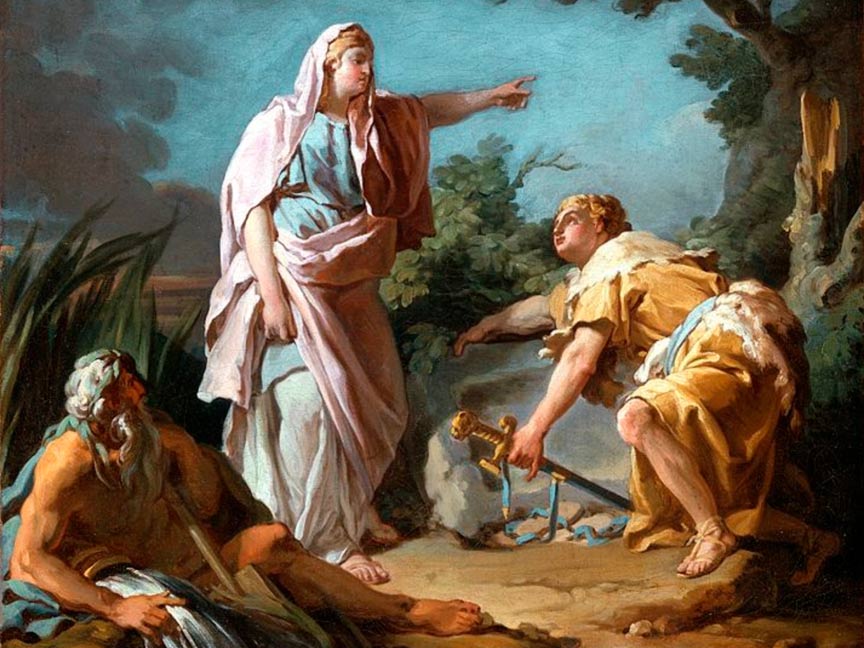The Legend of Aegeus - The Mistake of a Son and the Death of a King
Forty-three miles south of Athens, Greece, one can find the magnificent cliffs of Cape Sounion. This is a beautiful site with breathtaking sunset views over the Aegean Sea. Today’s beautiful scenery at Sounion draws many visitors who wish to marvel in the beauty of the landscape. However, Sounion is a location that offers more than just spectacular views. This site is an important location in Greek mythology.
The cape is surrounded by the Aegean Sea, which, according to Greek mythology, was named after Aegeus after he jumped to his tragic death due to a mistaken belief that his son had died. Additionally, Sounion is an archeological site, containing the ruins of an ancient temple of Poseidon. To an uninformed traveler, the beauty of Sounion may lie solely in the amazing sights where the cape meets the sea - but the myths and legends surrounding this area add even more wonder and beauty to the landscape as one imagines the ancient events that are said to have unfolded nearby.

The cliff of Cape Sounion and the Temple of Poseidon, Greece. Credit: SerrNovik / BigStockPhoto
Cape Sounion has been a site of many archeological finds. Overall, archeological explorations have uncovered artifacts that date back to 700 B.C. An original Temple of Poseidon is believed to have stood upon the cape until it was destroyed in 480 B.C., as Persian troops invaded Greece during the second Greco-Persian War. The Temple of Poseidon overlooked the sea, sitting on Cape Sounion at 60 meters (200 feet) above sea level. This is very fitting, as Poseidon was the god of the sea in classical mythology. The Temple was rectangular with columns on all four sides. A subsequent Temple was built over the remains from 444-440 B.C., and some of the columns still remain standing today.

The remains of the Temple of Poseidon at Cape Sounion, built circa 440 BC. Credit: Sborisov / BigStockPhoto
While the archeological finds at Cape Sounion are interesting and informative, many visitors are drawn to the Cape due to the tragic mythological tale which surrounds it. The myth explains the name of the sea the Cape overlooks.
According to Greek mythology, the Aegean Sea was named after mythological Greek King Aegeus after he flung himself off the cliff, to his death, upon the mistaken belief that his son had died. This ancient tragic tale involves a theme that is still used in modern story-telling today, which is that of misunderstanding and the tragic consequences that can follow.

Aegeus consults with Themis, Oracle of Delphi. Circa 440–430 B.C. Public Domain
King Aegeus was the grandson of the mythical ruler of ancient Athens, Erichthonius. Aegeus was first married to Meta, and then to Chalciope, but the pairings produced no children, and he left them. As the years passed and he remained without a male heir, he sought advice from the oracle at Delphi. Her prophecy confused him: "Do not loosen the bulging mouth of the wineskin until you have reached the height of Athens, lest you die of grief." Out of disappointment, he left to visit the wise King Pittheus of Troezen.
At Troezen, King Pittheus introduced his daughter Aethra to a drunken Aegeus, and the two lay with each other. Aethra became pregnant with Aegeus’ child, who grew to be known as the hero Theseus.

Theseus and Aethra by Laurent de la Hyre (Wikimedia Commons)
Before the baby was born, Aegeus left Aethra to return to Athens. Prior to leaving, he found a large, heavy rock, and placed his sandals and sword beneath it. He instructed Aethra that when he came of age, their son should retrieve the items and return to Aegeus. When he had grown, Theseus did retrieve the sword and sandals, and reunited with Aegeus in Athens. At first Aegeus didn’t recognize Theseus, but through tests he eventually realized it was his son returning to him.

Theseus recognized by his father by Jean-Hippolyte Flandrin (Wikimedia Commons)
At the time, Aegeus had been in conflict with Crete. King Minos of Crete had a son, Androgeus, who repeatedly defeated Aegeus in contests during the Panathenaic Games. Aegeus was jealous and embarrassed, so he suggested that Androgeus go to kill the Marathonian Bull. While attempting to do so, Androgeus was killed, and King Minos was so angered that he declared war on Athens. However, he agreed to peace under one condition – sacrifice. Minos created an elaborate labyrinth, within which he imprisoned the dreadful creature known as the Minotaur. Every nine years, Athens had to send seven male and seven female youths, known as tributes, to King Minos by ship. King Minos would then place the fourteen youths into the labyrinth to be devoured by the Minotaur. This was the price Athens had to pay for peace between themselves and Crete.

Mosaic depicting Theseus killing the Minotaur inside the labyrinth (Wikimedia Commons)
This continued on until the brave Theseus came alone and offered to help bring the practice to an end. One year, Theseus volunteered to go with the fourteen tributes so that he could slay the Minotaur. Aegeus was scared for his son’s life. To help ease his father’s fears, Theseus agreed that he would announce his fate by displaying white sails on his ship upon his return home. Aegeus waited on Cape Sounion, overlooking the sea, for his son’s return. When he saw Theseus’ ship approach with black sails, signifying Theseus’ death, Aegeus was devastated. He threw himself off the cliff and into the sea where he perished.
Unfortunately, this was all a tragic mistake. Theseus had successfully killed the Minotaur, and left the labyrinth very much alive. But he inadvertently forgot to change the black sails to white. This misunderstanding ended Aegeus’ life. The body of water hence became known as the Aegean Sea.

Sunset at Cape Sounion. Wikimedia, (CC BY-SA 3.0)
The mythological stories of Aegeus and Cape Sounion are retold as a tragic tale of a father who ended his own life under the mistaken belief that his son had died. As far as Greek mythology goes, the story of Aegeus and Theseus remains a classical example of a mistaken belief leading to tragic results.
Featured image: Aethra Showing her Son Theseus the Place Where his Father had Hidden his Arms (Wikimedia Commons)
Sources
Sounio Poseidon temple – Greeka. Available from: http://www.greeka.com/attica/athens/athens-excursions/sounio-poseidon-temple.htm
Sounion – Ancient-Greece. Available from: http://ancient-greece.org/archaeology/sounion.html
Aegeus – Encyclopaedia Britannica. Available from: http://www.britannica.com/EBchecked/topic/7001/Aegeus
Aegeus - In2Greece. Available from: http://www.in2greece.com/english/historymyth/mythology/names/aegeus.htm
By M R Reese



















